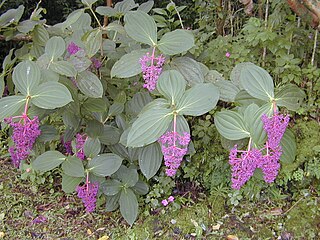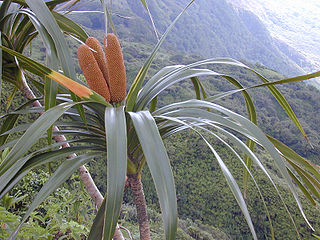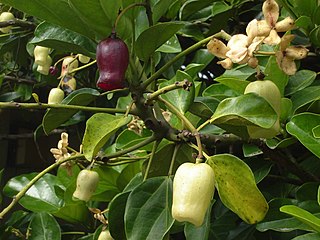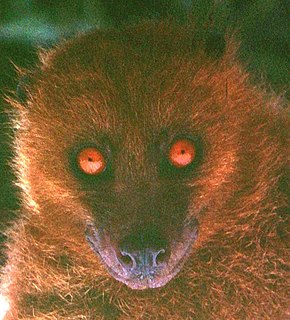
Hoya is an Asclepiad genus of 200–300 species of tropical plants in the family Apocynaceae (Dogbane). Most are native to Asia including India, China, Thailand, Malaysia, Vietnam, and Indonesia, There is a great diversity of species in the Philippines, and species in Polynesia, New Guinea, and Australia.

Medinilla is a genus of about 193 species of flowering plants in the family Melastomataceae, native to tropical regions of the Old World from Africa east through Madagascar and southern Asia to the western Pacific Ocean islands. The genus was named after J. de Medinilla, governor of the Mariana Islands in 1820.

The genus Pritchardia consists of between 24-40 species of fan palms found on tropical Pacific Ocean islands in Fiji, Samoa, Tonga, Tuamotus, and most diversely in Hawaii. The generic name honors William Thomas Pritchard (1829-1907), a British consul at Fiji.

Grammatophyllum, abbreviated in horticultural trade as Gram, is a genus of 13 currently known orchid species. The name is derived from the Greek words 'gramma' and 'phyllon' (leaf), referring to the parallel leaf veins or the markings of the perianth. This epiphytic genus occurs in dense rainforest from Indo-China, to Indonesia, the Philippines, New Guinea, and the Southwest Pacific islands.

Freycinetia is one of the five extant genera in the flowering plant family Pandanaceae. The genus comprises approximately 180–200 species, most of them climbers.

Claoxylon is a flowering plant genus in the spurge family, Euphorbiaceae, comprising dioecious subshrubs to small trees. It was first described as a genus in 1824. The genus is distributed in paleotropical areas: Madagascar through South and Southeast Asia, Malesia to Melanesia, Hawaiʻi, and Australia. Half of the species are in Malesia. According to a molecular phylogenetic study by Wurdack, Hoffmann & Chase (2005), Claoxylon is sister to Erythrococca, and together they form the top of a Hennigian comb-like phylogeny.

Bischofia is a genus of plants in the Phyllanthaceae first described as a genus in 1827. It is native to southern China, the Indian Subcontinent, Queensland, New Guinea, and various islands of the Pacific. It is the only member of the tribe Bischofieae.
- Bischofia javanicaBlume - S China, Taiwan, Ryukyu Is, Himalayas, India, Bangladesh, Assam, Andaman & Nicobar, Indochina, Malaysia, Indonesia, Philippines, Papuasia, Queensland, Fiji, Niue, Samoa, Tonga, Vanuatu, Cook Is, Society Is
- Bischofia polycarpa(H.Lév.) Airy Shaw - China

The genus Tacca, which includes the batflowers and arrowroot, consists of flowering plants in the order Dioscoreales, native to tropical regions of South America, Africa, Australia, Southeast Asia, and various oceanic islands. In older texts, the genus was treated in its own family Taccaceae, but the 2003 APG II system incorporates it into the family Dioscoreaceae. The APG III and APG IV systems continue to include Tacca in Dioscoreaceae.

Weinmannia is a genus of trees and shrubs in the family Cunoniaceae. It is the largest genus of the family with about 150 species. It is also the most widespread genus, occurring in Central and South America including the Caribbeans, Madagascar and surrounding islands, Malesia and the islands of the South Pacific. It is absent from mainland Africa and Australia, but some fossils have been attributed to Weinmannia in Australia. Leaves are simple or pinnate, with a margin usually toothed, and interpetiolar stipules. Flowers are bisexual, white, arranged in racemes. The fruit is a capsule opening vertically from the top to the base. Seeds hairy without wings.

Barringtonia is a genus of flowering plants in the family Lecythidaceae first described as a genus with this name in 1775. It is native to Africa, southern Asia, Australia, and various islands of the Pacific and Indian Oceans. The genus name commemorates Daines Barrington.

Atuna is a genus of plants in the family Chrysobalanaceae described as a genus in 1838. It is native to India, Southeast Asia, and various islands of the western Pacific.
- Atuna cordataCockburn ex Prance - Sabah
- Atuna elliptica(Kosterm.) Kosterm. - Fiji
- Atuna indica(Bedd.) Kosterm. - Kerala, Tamil Nadu
- Atuna latifrons(Kosterm.) Prance & F.White - Perak
- Atuna nannodes(Kosterm.) Kosterm. - Peninsular Malaysia, Borneo
- Atuna penangiana(Kosterm.) Kosterm. - Peninsular Malaysia
- Atuna racemosaRaf. - S Thailand, Peninsular Malaysia, Borneo, Philippines, Sulawesi, Sumatra, Maluku, New Guinea, Solomon, Bismarck, Santa Cruz, Fiji, Tonga, Samoa, Wallis & Futuna, Caroline
- Atuna travancorica(Bedd.) Kosterm. - Kerala

Melodinus is a genus of plant in family Apocynaceae, first described as a genus in 1776. It is native to Indomalaya, Meganesia and various islands in the western Pacific.
Northia is a genus of plants in the family Sapotaceae.

The Fijian monkey-faced bat or Fijian flying fox is a megabat endemic to Fiji. It was discovered in old-growth cloud forest on Des Vœux Peak, the second highest mountain peak on the island of Taveuni by William and Ruth Beckon in 1976, and is Fiji's only endemic mammal. It has recently been transferred from Pteralopex to its own monotypic genus Mirimiri.

Tropidia, commonly known as crown orchids or as 竹茎兰属 , is a genus of about thirty species of evergreen terrestrial orchids in the family Orchidaceae. They have thin, wiry stems with two or more tough, pleated leaves with a flowering spike at the top of the stem, bearing crowded flowers. Species in this genus are distributed across the warmer parts of both the Eastern and Western Hemispheres.

John Gould Veitch was a horticulturist and traveller, one of the first Victorian plant hunters to visit Japan. A great-grandson of John Veitch, the founder of the Veitch horticulture dynasty, he also visited the Philippines, Australia, Fiji, and other Polynesian islands.
Badusa is a genus of flowering plants in the Rubiaceae family. It was described by Asa Gray in 1860. The genus is native to the Philippines (Palawan), New Guinea, and some islands of the West Pacific.

Gymnostoma is a genus of about eighteen species of trees and shrubs, constituting one of the four genera of the plant family Casuarinaceae. The species grow naturally in the tropics, including at high altitudes having temperate climates, in forests in the region of the western Pacific ocean and Malesia. In New Caledonia, published botanical science describes eight species found growing naturally, which botanists have not found anywhere else (endemics). Additional species have been found across Burma, Sumatra, Borneo, the Philippines, Sulawesi, Ambon Island, the Moluccas, New Guinea, the Bismarck Archipelago, the Solomon Islands, and one endemic species each in Fiji and the Wet Tropics of Queensland, Australia.

Faradaya is a genus of plants in the mint family, Lamiaceae, first described in 1865. It is native to Indonesia, New Guinea, Australia, and some islands of the Western Pacific.
- Faradaya amicorum(Seem.) Seem. - Bismarck Archipelago, Solomon Islands, Samoa, Tonga
- Faradaya glabra(Moldenke) A.C.Sm. & S.P.Darwin - Fiji
- Faradaya lehuntei(Horne ex Baker) A.C.Sm. - Fiji, Tonga, Vanuatu
- Faradaya ovalifolia(A.Gray) Seem. - Fiji
- Faradaya splendidaF.Muell. - Borneo, Sulawesi, Maluku, New Guinea, Bismarck Archipelago, Solomon Islands, Bismarck Archipelago, Solomon Islands, Queensland
- Faradaya squamataH.J.Lam - Western New Guinea
- Faradaya vitiensisSeem. - Fiji
Rhopalephora is a genus of monocotyledonous flowering plants in the dayflower family, first described in 1864. It is native to Asia, Madagascar, and a few islands in the Pacific.
- Rhopalephora micrantha(Vahl) Faden - Java
- Rhopalephora rugosa(H.Perrier) Faden - Madagascar
- Rhopalephora scaberrima(Blume) Faden - China, Indian Subcontinent, Indochina, Borneo, Java, Philippines
- Rhopalephora vitiensis(Seem.) Faden - Maluku, Fiji, Samoa, Tonga


















